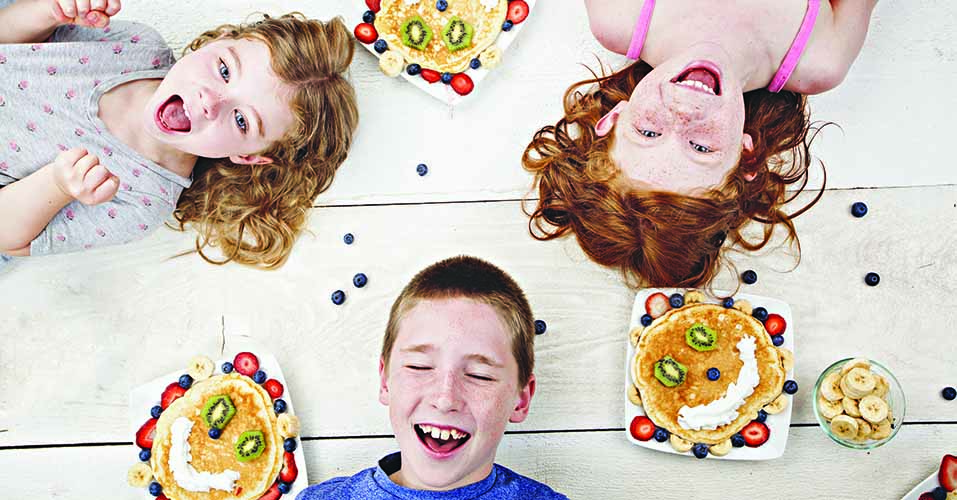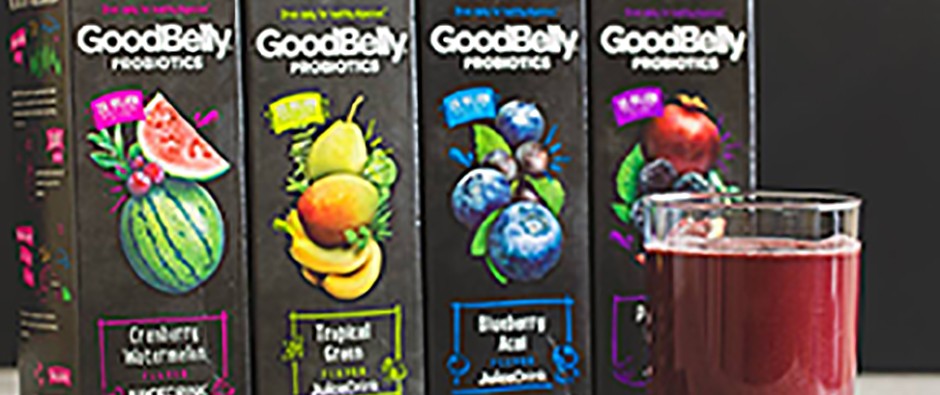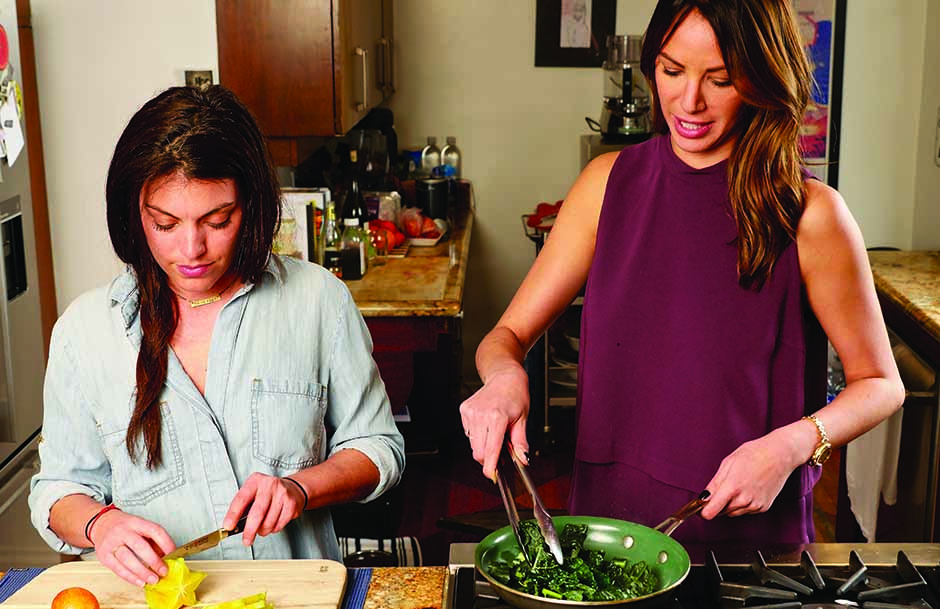Do your kids stick their tongues out at the sight of veggies? Do they fuss and frown when you put a healthy meal in front of them? It’s not easy being a parent sometimes, particularly when it comes to teaching your kids healthy habits and good nutrition.
To help you navigate the getting-your-kids-to-eat-well maze and connect with your kids in a way they understand and appreciate, we gathered advice and tips from a number of experts and parents on ways to make eating healthy fun. “Good nutrition plays a vital role in spiritual, physical and mental health,” says Melissa Halas-Liang, R.D.N., founder of SuperKids Nutrition, “and it can be achieved through small changes over time that will build momentum to create positive, powerful and lasting results.”
POSITIVE SPEAK: Talk positively with your kids about food and food exploration. For example, if you don’t like olives, don’t assume your child won’t like them. Be willing to try new foods with your children. Revisit those foods you disliked as a kid, and try them as an adult. Brussels sprouts are a great example; we know so many better ways to cook them now, versus boiling them to a mush. —Melissa Halas-Liang, R.D.N., founder of SuperKids Nutrition
THE LOOK: The visual feel of food really does make a difference. When I go into schools, I bring an apple spiralizer. When I spiralize an apple and show how it spreads out like an accordion, kids run toward it and want to try. I can’t keep up with the demand! I’ll also cut up a lesser-known vegetable, jicama, into little rectangles, pour a little bit of orange juice over, sprinkle some cilantro and put in a bowl. It’s cute and easy, and kids really enjoy it as a finger food. —Melissa Halas-Liang
FOOD DISGUISES: Be aware that kids may be more willing to try foods served at different temperatures, in different textures, shapes and sizes, and in unique food combinations. I make zucchini “coins” with my kids: we cut them in circles, roll in egg and whole-grain breadcrumbs, top with cheese and broil. My daughter brought over a friend who says she never eats veggies at home, and she loved the coins. My daughter also likes zucchini cut in strips for dipping in hummus. —Melissa Halas-Liang
EASY SNACKS: When you’re cooking dinner and your kids are clamoring that they’re hungry, tell them they can have a snack. Put out red pepper slices, or quickly heat up some frozen edamame in the microwave. This is one of the best ways get kids to eat veggies. You say, “I’m cooking dinner, this is all I have. No discussion.” —Melissa Halas-Liang
HIDE IT IN THE SOUP: Another way to get kids to eat more veggies is to make an easy soup. Put a few cups of broth in a pot, and top with an array of veggies. Cook until soft; then puree with an immersion blender. You can add some whole milk at the end. This makes the vegetables creamy and delicious. My daughter, who dislikes spinach, will often eat this soup for breakfast. And she’s excited to know a bowl counts as a vegetable serving! —Melissa Halas-Liang
PUT A FACE ON IT: Make food more whimsical and fun to eat. Put fruit chunks or cooked veggies on a skewer. Make bagels with faces: cukes for eyes, a sliced red pepper for a mouth, maybe some sprouts for hair. —Stephanie Harrington, mother of two
MEAL PREP: Get your kids involved in preparing meals. Ask them, “What shall we make tonight?” My kids and I love to do salads together. My son will help chop. My daughter, who is younger, will wash all of the veggies. Creating a meal together makes the process more fun, and it’s even more fun when we all sit down and eat the final dish together. —Stephanie Harrington
NO ‘JUST KID’ MEALS: Making separate meals that are “kid” meals doesn’t make sense. Just serve them smaller portions of whatever you’re preparing. I focus on meals with good protein and veggies, and grains that my kids will like. Sometimes it’s trial and error. And when you’re eating out, try to avoid the kids’ menu. Most often the choices are very carbohydrate heavy with not enough protein. Instead, order the kids smaller portions of healthier options from the main menu. —Stephanie Harrington
GO-TO MEALS: Build a repertoire of simple, go-to meals that take 30 minutes or less, and incorporate ingredients and flavors familiar to your kids. My go-to meal is a sheet-pan dinner. An absolute favorite is tossing some beans, corn kernels and chopped tomatoes in olive oil, spreading them on a baking sheet, laying a few fillets of salmon on top, and roasting. —Stephanie Harrington
JUNK FOOD: Don’t deny your kids “unhealthy” foods. I grew up with a mom who was vegan—I remember a lot of wheat germ and tofu. And I was so envious of kids who ate junk food. So I try not to make it so strict for my kids. I’ll tell them, “You can try that,” but not always. I try to find a nice balance. I’ll sometimes put a homemade cupcake in their lunch, for example. And we always have ice cream in our freezer. There are a lot worse foods out there. —Stephanie Harrington
EAT TOGETHER: Make family meals a central part of your daily life. Every family has a busy schedule with sports and after-school activities, so slow down, sit down and eat dinner together as often as possible. Turn off the TV and other devices—get away from the blue screen—and enjoy a nice conversation. —Chef Ann Cooper, founder of the Chef Ann Foundation and partner of Lunch Lessons, LLC
SHOPPING IS FUN: Take your kids grocery shopping. When you’re in the produce section, ask them if there is something they’d like to try, and then talk about ways to prepare it. By injecting your kids into the shopping process, it helps them feel more a part of decision-making for food and meals. —Chef Ann Cooper
Fill in Nutritional Gaps
It’s hard to get your kids to eat well every day, so consider filling in the nutritional “gaps” with a multivitamin. One of our favorites is Ester-C Kidstiks, powder stick packets that you simply dissolve in a glass of water. Each packet contains 250 mg of vitamin C for immune health, plus essential vitamins like B6 and B12 to support energy metabolism, and calcium and magnesium for strong teeth and bones. Comes in two kid-friendly natural flavors: Groovy Grape and Tropical Punch. Learn more at americanhealthus.com.
Get Kids Moving, Too
Physical activity and good nutrition go hand in hand to keep kids healthy. So as you teach good eating habits, don’t forget to encourage some fun ways to exercise, too. It can start at the school level.
Charlene Burgeson, executive director of Let’s Move! Active Schools, shares how students at one elementary school started a student wellness team called The Wellness Warriors. On a given school day, you might find a member of the team helping with the school’s running and walking program, leading a Fitness Week activity, or passing out information about an upcoming Walk or Bike to School Day.
If your kids’ school isn’t already connected with the Let’s Move! Active Schools program, learn more at letsmoveschools.org.










Comments